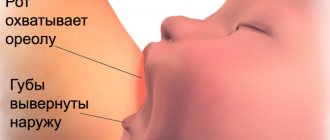When does milk appear after childbirth?
Lactation does not improve immediately; the body needs time. First, colostrum is produced, then transitional, and then mature milk. It takes about 3 months for lactation to develop.
When milk arrives after childbirth depends on the efforts of the woman herself and physiology, for example, in multiparous women this process accelerates. Milk production is regulated by the hormone prolactin, which is synthesized under the influence of another hormone, oxytocin. The latter is produced during breastfeeding.
Therefore, the more often a woman puts her baby to her breast, the faster and in greater quantities milk will appear.
When does milk come in if the baby is premature?
Sometimes, the baby is born prematurely. The reasons can be very different:
- severe stress;
- factors that threaten the life of the mother or child;
- chronic maternal illness;
- multiple pregnancy;
- placental abruption;
- and others.
Labor may begin prematurely, unexpectedly or as directed by a doctor. In such cases, women begin to think about whether their lactation will be established and whether they will be able to breastfeed their child in the future.
However, there is no need to panic ahead of time. Statistics “show” that even with a premature pregnancy you will be able to feed your baby with your milk, there is only one question: after how many days?
Often, even colostrum can be “late” and not appear immediately after the baby is born. However, it comes. Of course, milk production also becomes somewhat distant. Usually, a young mother notices the first “white droplets” 7-8 days after birth.
How to tell when milk has arrived
It is impossible to miss the moment when milk arrives after childbirth. What does a woman feel?
A young mother can understand that milk has come in after childbirth because of the heat in her chest. You immediately feel warm. In most cases it arrives suddenly and in large quantities.
Signs of milk coming in after childbirth:
- bloating, increase in breast size;
- hardening, bulging veins;
- painful sensations;
- increase in body temperature.
Finding out that milk has come in after childbirth is very simple. You need to try pumping or just pressing on your chest. The milk will splash out like a fountain.
Sometimes lactation begins smoothly. The woman does not feel any discomfort, there is no feeling that her breasts are about to explode from overflowing, and the milk does not spurt out.
There is no need to worry, all negative sensations disappear as soon as lactation improves. This happens within 2–4 weeks.
The first milk is white, sometimes with a yellowish or bluish tint. It has a watery or runny consistency.
Yellow milk after childbirth is colostrum. It is high in calories and thick. There is not much of it - from 5-6 drops to 100 ml per day.
Is the baby getting enough nutrition?
After giving birth, the most difficult thing is to understand that there really is enough milk, and not to look for ways to induce it. Mom can be guided by the following signs:
- how many times does the baby pee - by the third day this should happen 6-8 times, if less, dehydration is possible;
- how the stool changes - from black meconium in the first days to green and brown; when milk arrives after childbirth, the color turns yellow and the consistency becomes like mustard;
- the number of bowel movements is up to two or three times a day, although it happens after each feeding;
- a feeling of some fullness in the breasts before feeding, some emptying after, wetness of the bra in small quantities between feedings; but all this stops at about one month of age of the child, milk after birth comes in sufficient quantities when the child suckles on demand;
- baby’s behavior during feeding – vigorous sucking, swallowing sounds;
- The general condition of the baby is a satisfied, healthy appearance.
Control feeding during natural feeding very rarely shows real results. If the baby just wants to drink, then he can suck out only 10 g. This is not a reason after birth to worry about why the milk is not coming. Provided that the baby grows normally, gains weight, and develops.
The same goes for weight gain. The tables are very average, and some babies may gain weight less intensely, others more. In general, weight is a relative indicator. If everything goes well, then small deviations cannot be a sign of pathology. The normal limits for a baby older than a week are from 125 to 500 g per week.
Most newborns ask for the breast 10-15 times a day
You cannot judge that milk comes in small quantities after childbirth based on the condition of your breasts. By about a month, with the right approach to feeding, the breasts are almost always soft. Milk begins to be produced in it only while the baby is sucking. If you “accumulate” milk between feedings, its amount will begin to decrease.
What to do when milk appears
So the milk arrived. The breasts became hard and began to hurt. What to do? It is necessary to accustom her to the production and release of milk, then the sensations will normalize. You need to attach the baby as often as possible.
Yes, there will be even more milk, but that’s how it should be. Excess will flow freely, this is also normal.
Recommendations for breastfeeding to normalize lactation:
- Apply the baby to the breast not according to time, but at will - the more often, the better. But we must not forget about the duration of feeding. If the baby eats for more than 20 minutes at a time, cracked nipples are likely, especially in the first weeks of lactation.
- In some cases, after feeding, it is worth checking the breasts to see if they are empty. If there is any milk left, express it. This is necessary to stimulate milk production. If there is already enough of it, then there is no need to express it to the end. This technique is also justified for those women who feed on a schedule - the frequency between feedings increases, and less milk may be produced, then pumping may be useful.
- Feed at night. If the baby is sleeping and the chest is full, it is worth waking up the baby. For now, we will have to switch to the feeding mode “at the mother’s request.”
What to do in the first days so that milk comes on time
In order for milk to come in faster after birth, you need to put the baby to the breast more often. There are no special tricky or magical ways to stimulate lactation. All processes in a woman’s body are already laid down by nature. Therefore, a young mother just needs to be close to the child, learn to feel his desires, breastfeed on demand, support night feedings and not limit the time of sucking. It is important to learn how to properly latch on to your baby so that the baby gets enough nutrition and the mother does not have problems with breastfeeding.
Correct application
In order for milk to appear, the baby must be applied to the breast correctly. Full nipple latching allows for maximum suction of the contents and prevents the baby from swallowing air. Thanks to proper attachment, the baby remains full, he does not have colic, and the mother does not develop cracks and does not experience lactostasis with the arrival of milk.
For proper attachment, you need to turn the newborn towards you with his tummy. His muscles are weak enough to turn his neck on his own. The nipple should be brought close to the newborn's mouth. The baby's mouth should be wide open. It is necessary to place the nipple in the mouth so that the baby captures the areola as much as possible. It is more convenient to do this lying down, positioning the baby “from the armpit”.
Correct application looks like this:
- the baby's mouth is open wide and completely or almost completely captures the areola of the nipple;
- the lower lip is “turned” outward;
- the chin is in contact with the skin of the mammary gland;
- a small part of the areola protrudes from under the upper lip (less than from under the lower lip);
- sucking movements are deep and slow.
Feeding on demand and staying together with the mother in the maternity hospital
After childbirth, milk comes quickly if there is a demand for it. Therefore, maternity hospitals organize the baby and mother to stay together. It is advisable that in the first two hours after birth the baby is at the breast and periodically sucks. Stimulation of the mammary glands has a beneficial effect on the condition of the uterus and causes it to contract.
It is recommended to latch on to the baby on demand, rather than forming a regimen of feeding. The first two weeks are of particular importance, since during this period the active development of glandular tissue occurs. The more often the baby is attached and the longer he sucks on his mother’s breast, the more milk will be produced.
With breastfeeding on demand, the child independently regulates the frequency and duration of attachments. In the first days after birth, he can suckle often and little by little. Contrary to the recommendations of some pediatricians, you cannot wait 2-3 hours until the child begins to scream heart-rendingly.
Night feedings
To make milk appear faster, you need to feed the baby at night and early in the morning. At this time, prolactin is produced. Stimulation of the breast ensures its entry into the blood. Breastfeeding consultants say that one of the foundations of successful lactation is night feeding.
Co-sleeping makes nighttime feedings easier for mom. If the baby is sleeping in the crib, the woman has to get up when the baby calls. Being close to the mother, the baby may not wake up and suckle, independently regulating the duration and frequency of attachments.
Supplementary feeding only for strict medical reasons
In maternity hospitals, you can often encounter forced supplementary feeding of a child, when he is taken away from his mother in the first hours after birth and offered formula. It is necessary to avoid such situations, since supplementary feeding with formula is the first enemy of full lactation.
It is necessary to distinguish between children who cannot eat mother's milk and those who have difficulty consuming it. Supplemental feeding should be done only for medical reasons:
- galactosemia;
- anatomical defects associated with cleft lip or other jaw abnormalities;
- some somatic pathologies in women;
- viral immunodeficiency;
- open form of tuberculosis.
Is it necessary to “decant”?
Often in maternity hospitals they offer to develop or strain the breasts. Midwives or nannies knead women's breasts, develop nipples, forcing the gland to work as needed. However, such manipulations are not only useless, but also dangerous. After the barbaric painful “straining” the woman is left with dents, bruises and bruises. Later, patients become visitors to mammologists and surgeons, as they are faced with severe lactostasis and mastitis.
Modern doctors and breastfeeding consultants do not accept this approach. The formation of lactation should be painless and comfortable. It is recommended to take a break between applications for no more than two hours in the first days. You can feed more often, but not less often.
Drinking enough
The volume of fluid does not affect the amount of breast milk. Therefore, you should not pour liters of water into yourself. This will lead to swelling of the body and chest. You need to drink as much as your body requires.
When milk comes in in large quantities, the mother is advised to limit fluid. But this method does not help cope with the volume of baby food. Lack of fluid also causes swelling as the body accumulates water in the soft tissues.
Are lactogenic teas necessary?
Lactonic agents are not able to speed up the appearance of milk. Therefore, there is no need to stuff yourself with teas and pills. Only a child can stimulate milk production.
Also, some herbal teas can cause an allergic reaction in the baby, so it is better to avoid them in the first days after birth.
Problems
Both first- and multiparous women may experience hypolactation (insufficient lactation) or hyperlactation (excessive lactation). Both conditions need to be corrected. Not a single woman’s lactation improves as if by magic immediately after giving birth - it literally adapts to the needs of the child.
If there is not enough milk
This problem occurs most often. It can be solved on its own with the help of the right breastfeeding. Sometimes medications and physical therapy are required.
What to do if there is little milk after childbirth:
- put the baby to the breast as often as possible to stimulate the production of oxytocin;
- ensure regular physical contact with the baby;
- express after feeding;
- drink at least 2 liters of liquid per day;
- provide a balanced diet so that the woman does not experience a deficiency of nutrients;
- Rest and good mood will help speed up the flow of milk after childbirth;
- take tablets to increase lactation, for example, Apilak.
Injections of oxytocin will help produce milk after childbirth.
What to do if there is no milk
Milk should come within a week after birth. But it happens that he is not there. The reasons are as follows:
- endocrine disorders, diabetes mellitus and other serious diseases of women;
- decreased production of prolactin, oxytocin;
- stress;
- exhaustion of the body;
- unbalanced diet;
- complicated birth, for example, large loss of blood.
If there is no milk, you cannot give up and immediately give up breastfeeding, completely switching to artificial feeding. Every effort must be made. In order for milk to come in faster after childbirth, you need to put your baby to the breast as often as possible, eat right, drink plenty of fluids and rest, and not worry.
What to eat to improve lactation? It is necessary to eat fermented milk products, nuts (no more than 2-3 per day, so as not to cause colic in the child), carrots, fennel, ginger, seeds, and currants. They have lactogenic properties.
It is important for women to remember that no formula can replace milk, so it is necessary to feed the baby for as long as possible. Lactation consultants will help normalize lactation.
Photo: depositphotos.com











